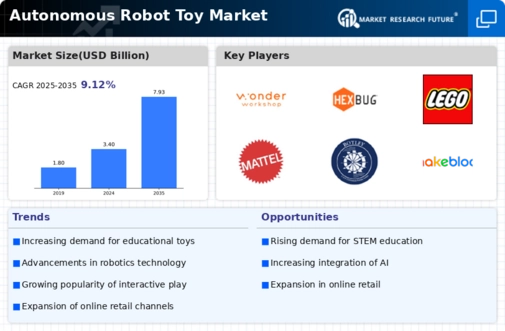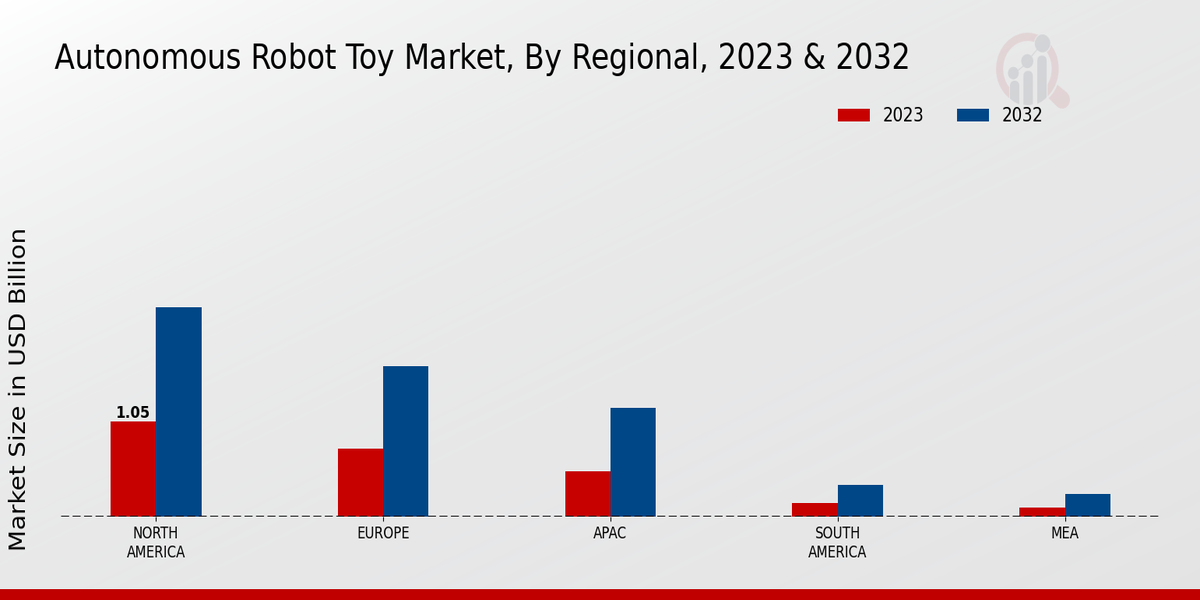Market Growth Projections
The Global Autonomous Robot Toy Market Industry is projected to experience substantial growth in the coming years. The market is expected to reach 3.4 USD Billion in 2024 and is anticipated to grow to 7.93 USD Billion by 2035. This growth trajectory suggests a compound annual growth rate of 8.01% from 2025 to 2035, indicating a robust demand for autonomous robot toys. Factors such as technological advancements, increasing demand for educational tools, and the rise of interactive play are likely to contribute to this positive outlook. The market's expansion reflects broader trends in consumer preferences and technological innovation.
Expansion of E-commerce Platforms
The expansion of e-commerce platforms is reshaping the Global Autonomous Robot Toy Market Industry by providing consumers with greater access to a diverse range of products. Online shopping has become increasingly popular, allowing consumers to compare prices and read reviews before making purchases. This trend is particularly advantageous for niche products like autonomous robot toys, which may not be widely available in physical stores. The convenience of online shopping is likely to drive sales, contributing to the market's growth trajectory. As e-commerce continues to evolve, it may play a pivotal role in shaping consumer behavior in this sector.
Rising Popularity of Interactive Play
The Global Autonomous Robot Toy Market Industry is witnessing a rising popularity of interactive play experiences among children. Toys that can respond to commands, engage in conversations, and adapt to user behavior are increasingly favored by consumers. This shift towards interactive play is driven by the desire for toys that not only entertain but also educate. As children become more tech-savvy, the demand for these interactive toys is likely to grow. This trend may contribute to a compound annual growth rate of 8.01% from 2025 to 2035, indicating a robust market trajectory.
Technological Advancements in Robotics
The Global Autonomous Robot Toy Market Industry is experiencing a surge in technological advancements that enhance the capabilities of robotic toys. Innovations in artificial intelligence, machine learning, and sensor technologies are enabling these toys to interact more intelligently with users. For instance, toys equipped with voice recognition and adaptive learning features are becoming increasingly popular among consumers. This trend is likely to drive market growth, as parents seek engaging and educational toys for their children. The market is projected to reach 3.4 USD Billion in 2024, reflecting the growing demand for technologically sophisticated products.
Increasing Demand for STEM Education Tools
There is a notable increase in the demand for toys that promote STEM education, which is significantly influencing the Global Autonomous Robot Toy Market Industry. Parents and educators are increasingly recognizing the importance of early exposure to science, technology, engineering, and mathematics. Autonomous robot toys serve as effective tools for teaching these concepts in a fun and engaging manner. This trend is expected to contribute to the market's growth, with projections indicating a rise to 7.93 USD Billion by 2035. The integration of educational content within these toys aligns with the global push for enhanced educational resources.
Growing Parental Awareness of Child Development
Parental awareness regarding the importance of play in child development is significantly influencing the Global Autonomous Robot Toy Market Industry. Parents are increasingly seeking toys that promote cognitive skills, creativity, and problem-solving abilities. Autonomous robot toys, which often incorporate educational elements, are perceived as beneficial for children's development. This growing awareness is likely to drive demand, as parents prioritize toys that offer both entertainment and educational value. As a result, the market is expected to expand, reflecting a shift in consumer preferences towards developmentally supportive products.





















